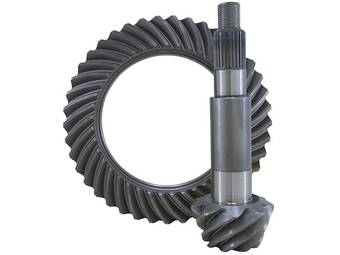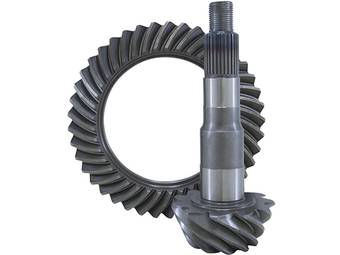Get Up to 60% Off Steps – Shop Now
Select Your Vehicle
1986 Chevy Camaro Ring & Pinion Gear Sets
Ring and pinion gears are a crucial component of your pickup’s differentials, translating the rotational force of the driveshaft to the axle shafts and, thus, the wheels. The gears are precision machined and manufactured from high-strength 8620 or 4320 steel for maximum durability and longevity.
Why Replace Your Ring & Pinion Gears?
One may wish to replace their vehicle’s ring and pinion gears for several reasons, from normal wear and tear to improving performance and driveability. Some of the most common justifications include:
Changing Axles Ratios: When replacing your factory ring and pinion gears, you can opt for different-sized gears with different tooth counts, thus altering how many revolutions of the pinion gear are required to rotate the ring gear. This value is known as the gear ratio, or the ring gear tooth count divided by the pinion gear tooth count.
Towing Larger Loads: For vehicles that routinely tow heavy loads, installing a shorter ratio gear set helps maintain torque throughout the RPM band, thus increasing towing performance.
Restoring Lost Performance: After installing oversized tires, increasing wind resistance, and adding weight to your vehicle, you’ll likely notice decreased performance. Just like when towing, replacing your vehicle’s ring and pinion gear set with shorter gears helps maintain torque, thus improving around-town driveability to compensate for the added weight and rotational mass.
Addressing Wear & Tear: After multiple years and hundreds of thousands of miles driven, your vehicle’s ring and pinion gears can incur excess wear, ranging from worn to chipped teeth. This wear often results in poor driveability, including clunking, whining, and howling at high speeds.
Understanding Axle Ratios
Every ring and pinion gear set has a ratio, typically expressed as X.XX; some of the most common, especially for truck drivers, include:
3.21
3.55
3.73
3.92
4.10
4.56
4.88
5.13
These values are ratios, depicting the number of teeth of the ring gear (larger gear bolted to the carrier) divided by the number of teeth on the pinion gear (smaller gear with a shaft extending through the differential case.) Typically, the higher the numerical value, the shorter the gear ratio, and more torque, whereas the lower the numerical value, the taller the ratio and the more efficiency.
When determining which gear ratio is correct for your application, it’s best to select a gear set that best mimics factory specifications. For example, if you’d like to increase around-town driveability after installing oversized tires, follow the formula:
(new tire diameter) / (old tire diameter) x (current gear ratio) = (new gear ratio)
This formula will recommend a gear ratio that best fits your needs; simply round up to the nearest gear ratio for added torque, or round down for better fuel economy.
Ring & Pinion Gear FAQs
Q: What do the ring and pinion gears do?
A: Your vehicle’s ring and pinion gear transfer the rotational force of the driveshaft, through the attached axle flange, into the ring gear bolted to the differential carrier. This force is then applied to the axle shafts, thus allowing your vehicle to move. In short, the ring and pinion gears bridge your vehicle’s driveshaft(s) and axles.
Q: How does tire size affect RPM?
A: The larger the tire, the more distance your vehicle can cover with a single revolution, allowing you to travel at the same overall speed while maintaining a lower engine speed. For example, if a truck running 33-inch tires spins 2,500 RPM at highway speeds to travel 65 MPH, installing 35-inch tires would require less RPM to travel at the same overall speed, approximately 2,200 RPM. This is due to the greater distance being covered with each full revolution of the tire.
Q: What causes damage to ring and pinion gears?
A: Ring and pinion damage may result from any number of sources, though the most common include lack of maintenance, abuse, or age/mile


